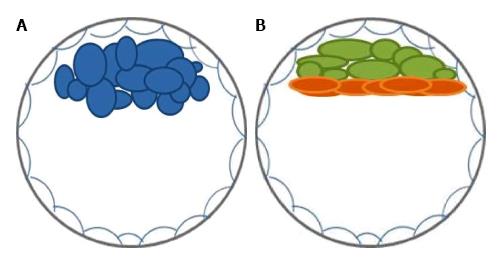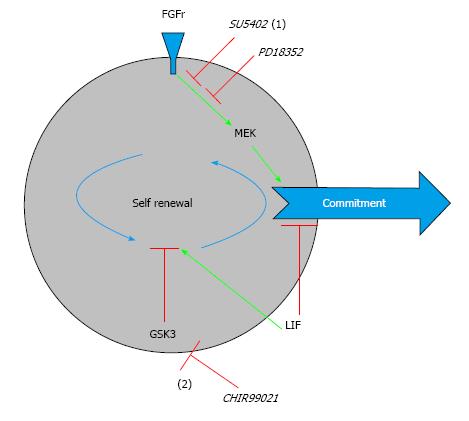Copyright
©The Author(s) 2015.
World J Stem Cells. Apr 26, 2015; 7(3): 649-656
Published online Apr 26, 2015. doi: 10.4252/wjsc.v7.i3.649
Published online Apr 26, 2015. doi: 10.4252/wjsc.v7.i3.649
Figure 1 First two cell segregations during preimplatation embryonic development.
A: In blue, cells from the inner cell mass (ICM) in the early blastocyst, and white, cells from the trophectoderm; B: At the late blastocyst stage, cells from the ICM segregate into cells from the epiblast (green) and the primitive endoderm (orange).
Figure 2 Maintenance of pluripotency by leukemia inhibitory factor and small molecules.
Green arrows indicate activation, red blunted lines indicate inhibition. The pluripotent cell must self-renew without committing to any specific cell type. This may be achieved by promoting self-renewal and inhibiting commitment by LIF; or by small molecules (in italic) which inhibit (1) signaling through the FGF receptor tyrosine kinase, thus inhibiting commitment; and (2) GSK3, promoting self-renewal. Adapted from[33]. LIF: Leukemia inhibitory factor; FGFr: Fibroblast growth factor receptor-specific tyrosine kinase; GSK3: Glycogen synthase kinase 3; MEK: Mitogen-activated protein kinase.
- Citation: Fonseca SAS, Costas RM, Pereira LV. Searching for naïve human pluripotent stem cells. World J Stem Cells 2015; 7(3): 649-656
- URL: https://www.wjgnet.com/1948-0210/full/v7/i3/649.htm
- DOI: https://dx.doi.org/10.4252/wjsc.v7.i3.649










